Why you’ll love it
This Japanese sesame sauce or sesame dressing is a classic condiment in Japan. Known in Japan as goma dare, it has a rich, nutty, sweet, savoury and tangy flavour and is very easy to make at home. While a common shop-bought sauce includes Kewpie mayonnaise, this more traditional version is mayo-free and vegan.
Used as a dressing or dip, this sesame sauce is very versatile, from dressing an Asian slaw or steamed veggies to dipping gyoza, tofu and meats. It’s also fantastic stirred through noodles. The possibilities really are endless!
This Japanese sesame sauce recipe takes just a few minutes to make and is very easy to adjust to your tastes and what you’re using it for.
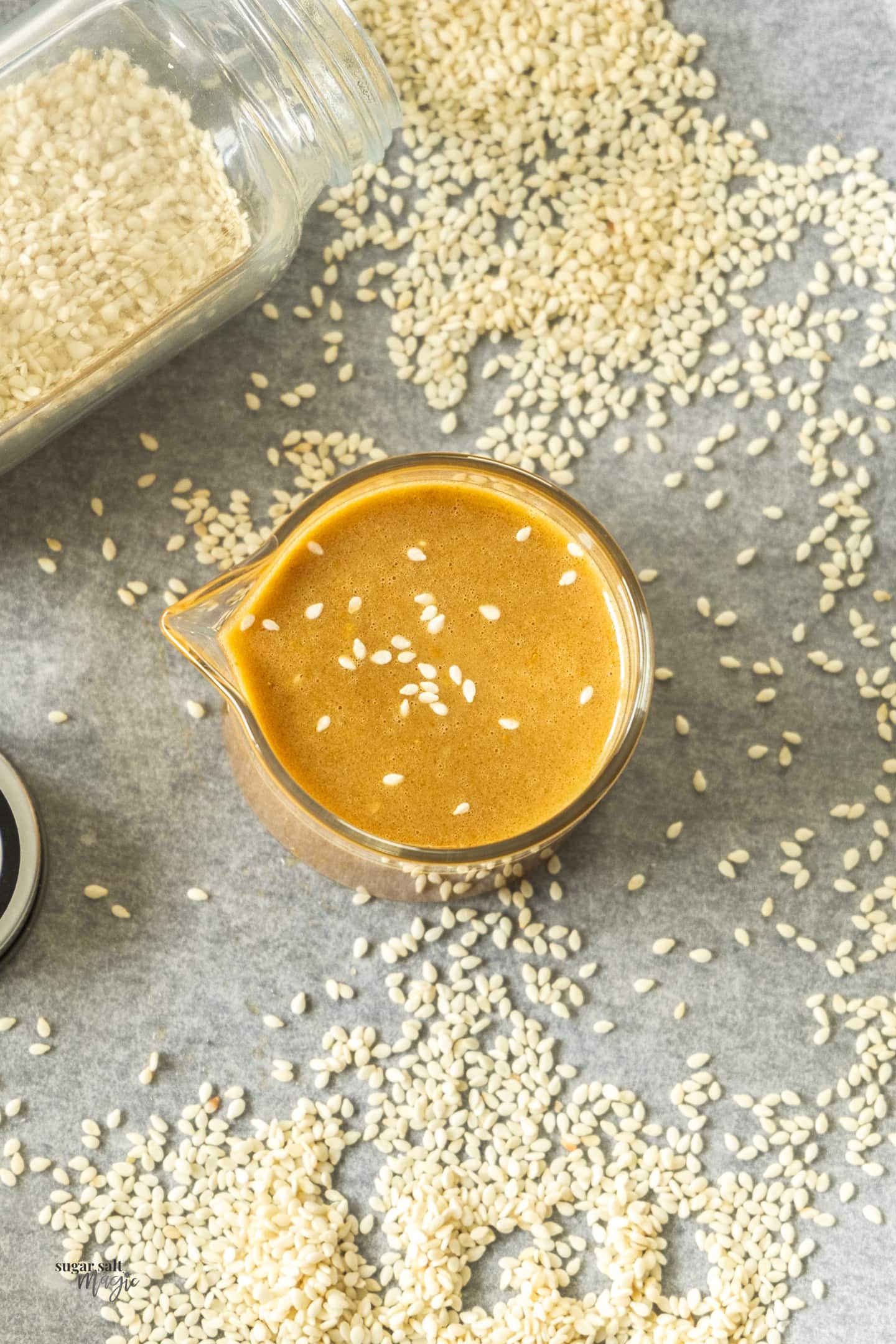
Never Miss a Recipe!
Get the latest recipes straight to your inbox!
What is goma dare
Goma dare (goma meaning sesame and dare meaning sauce), is a classic Japanese condiment made with sesame seeds, rice vinegar, soy sauce, sesame oil and sugar. It’s very often and very easily varied to taste with some recipes adding dashi powder, while others add miso paste or garlic. This one has some ginger which gives tang, sweetness and warmth.
Often served up with shabu shabu (a Japanese hot pot where you add the ingredients you like to a hot soup stock and it all cooks right in the middle of the table), my local Japanese takeaway dresses their side salad with sesame dressing and it’s just lovely in so many ways.
The base of the flavour comes from the roasted sesame seeds which takes just a few minutes in a dry pan. The recipe as it’s written here is perfect for use as a salad dressing or for dressing noodles and it is good for dipping too however, you can increase the amount of sesame seeds to thicken the sauce and add even more nuttiness and creaminess.
Ingredients in Japanese sesame sauce
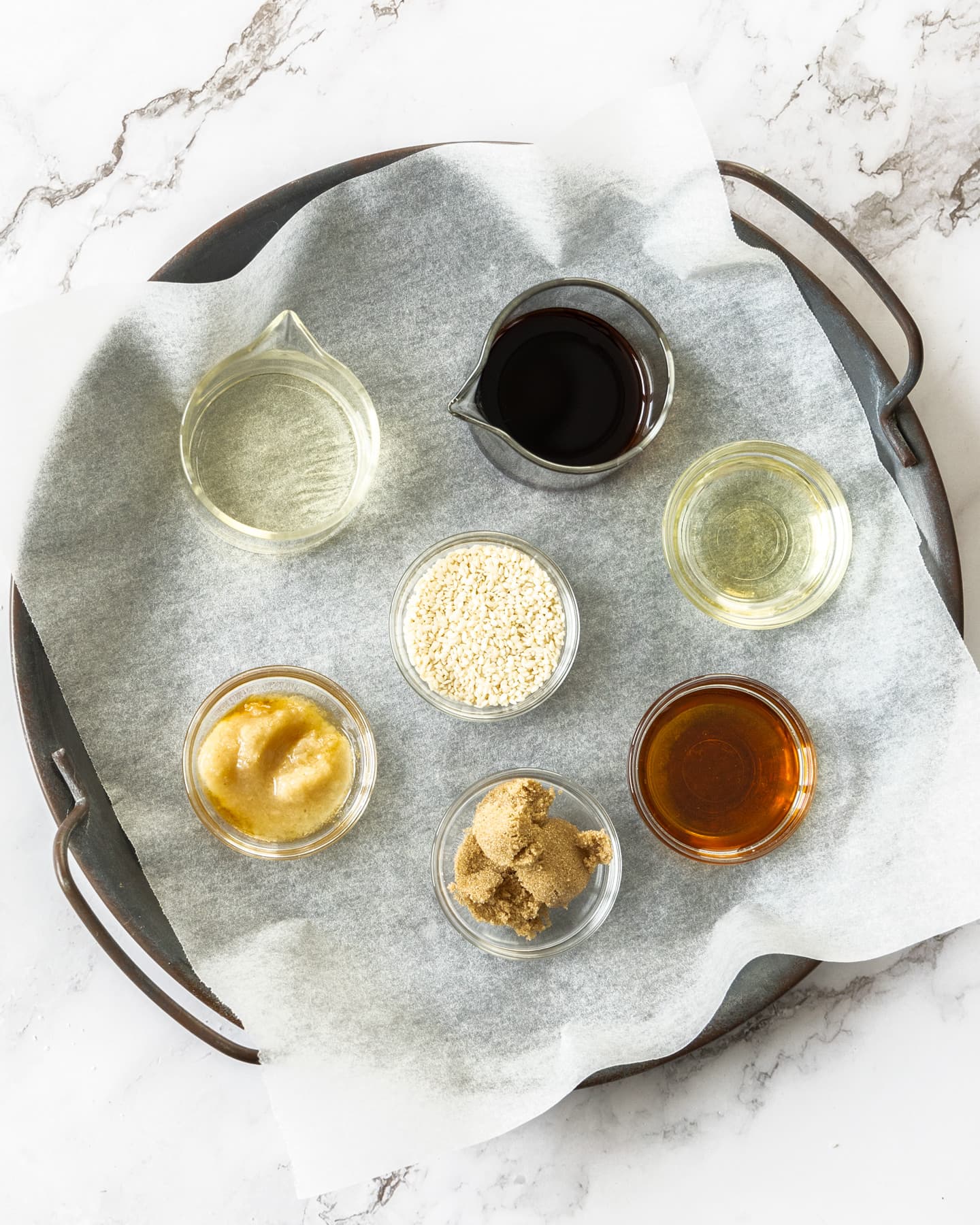
Jump to the recipe for full ingredients and instructions.
- Sesame seeds: Regular white sesame seeds are toasted or roasted until golden then ground up in a spice grinder or mortar and pestle to a powder. This is the base of this Japanese sesame sauce. If you can find it, you can also use Japanese sesame paste from a jar, though it may not have quite as strong a flavour. Tahini, though you could use it in a pinch, definitely won’t give the same flavour as it is made from raw sesame seeds, not toasted seeds.
- Rice wine vinegar: Rice vinegar is a slightly sweet vinegar used extensively in Japanese cuisine.
- Soy sauce: Go for a good traditional Japanese soy sauce here like Kikkoman.
- Toasted sesame oil: Also known as roasted sesame oil, this is one of my favourite ingredients. It’s rich, nutty, and loaded with umami.
- Vegetable oil: I add a little neutral-flavoured vegetable oil to my goma dare but you can up the sesame flavour by adding more sesame oil.
- Light brown sugar: A little light brown sugar adds the perfect amount of sweetness.
- Ginger: I just love the addition of ginger to my goma dare. It has a natural spiciness but is also tangy and a little sweet. It adds great depth and complexity to the dressing.
How to make goma dressing
Japanese sesame sauce (or goma dare) is extremely simple to make. I sometimes make a double batch and keep it in the fridge for another dinner meal later in the week.
Jump to the recipe for full ingredients and instructions.
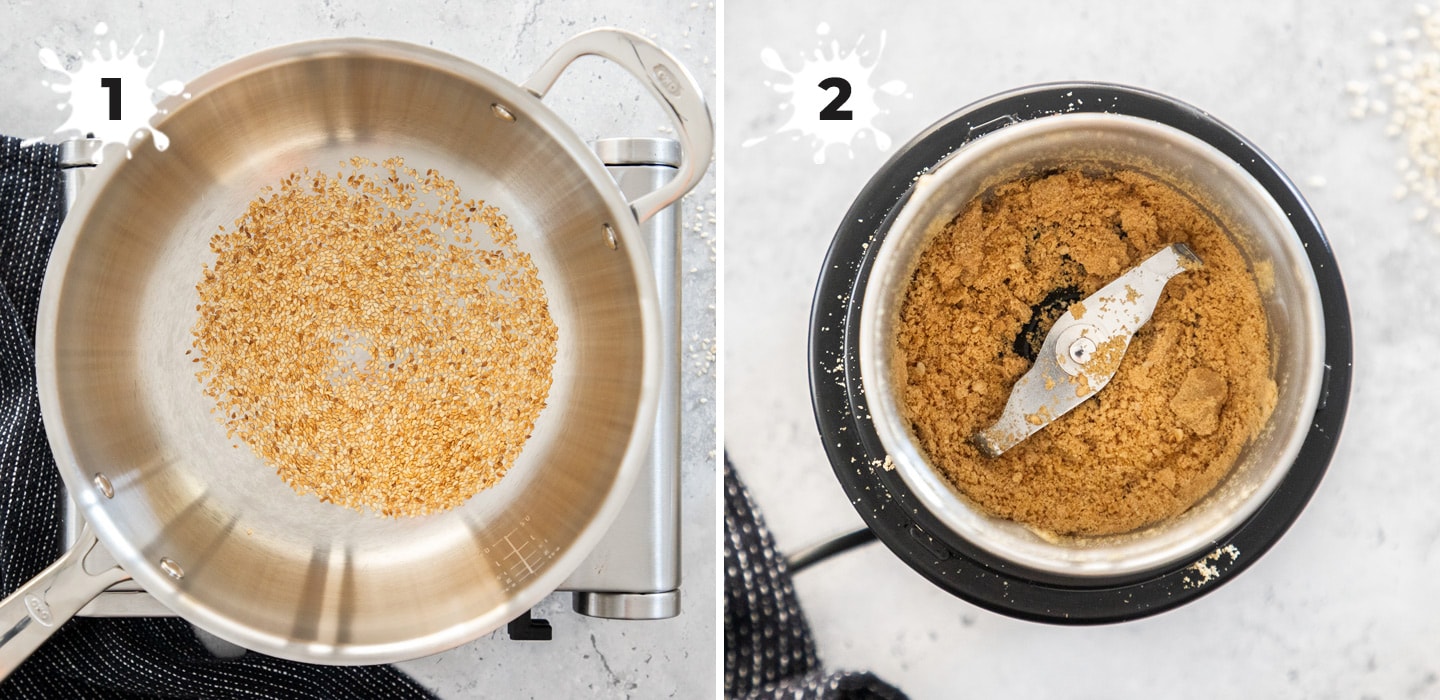
- Toast the sesame seeds: You can toast the sesame seeds in a dry pan on the stovetop (photo 1) like I do. Just move them around the pan regularly until they turn golden and start to smell like popcorn. You can also roast the sesame seeds in the oven. Place them on a baking sheet in a moderate oven for 5-8 minutes.
- Grind the sesame seeds: Now you need to grind the sesame seeds to a fine powder (photo 2). I love the simplicity of a spice grinder (or coffee grinder) but a mortar and pestle or mini food processor will do the job too.
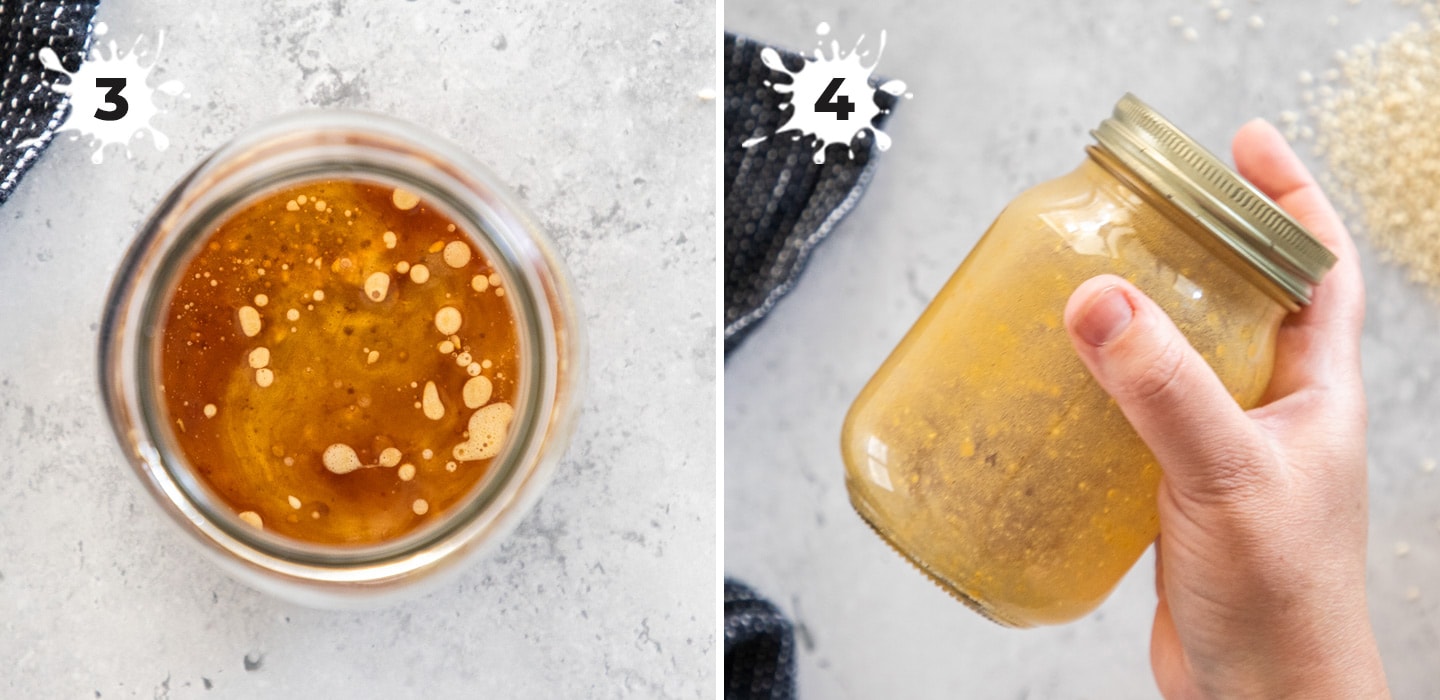
- Mix it all together: Now you just need to add all the ingredients to a mason jar (photo 3) and give it a good shake (photo 4).
Tips and tricks
- Feel free to increase the amount of sesame seeds in your goma dressing. They will add more sesame flavour but will also adjust the consistency. The consistency of the recipe as written is perfect for salads and does well for dipping too but if you want to make it thicker, try using as many as 3 or 4 tablespoons of sesame seeds.
- You may be able to find Japanese sesame paste in your local Asian grocery store. This may give a slightly more subtle flavour. Chinese sesame paste can also work. Tahini is made using raw sesame seeds so won’t give the same flavour but you can add more sesame oil to make up for it flavour-wise.
- Add some Japanese Kewpie mayonnaise if you want a creamier flavour.
Turn it into a noodle sauce
Transform simple noodles smothered with this Japanese sesame sauce and a couple of extras; it tastes seriously irresistible.
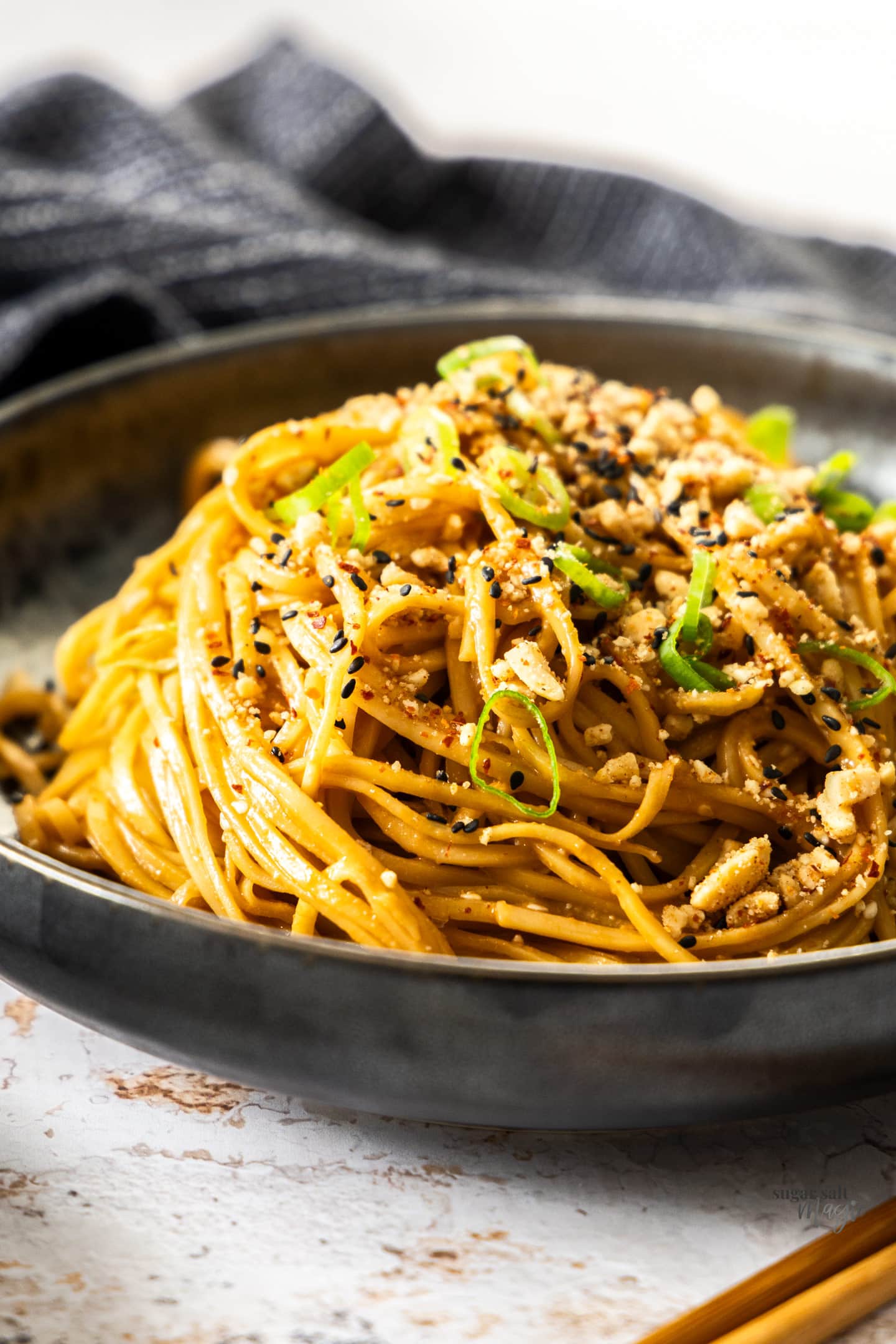
These sesame noodles are incredibly quick to make and work as a side dish for 4 or a meal for 2-3 depending on hunger levels and they’re utterly delicious.
- First, cook 250g dried egg noodles according to the packet instructions. Drain, then rinse with water (warm water if you want to serve them hot), then toss with a dash of sesame oil and set them aside.
- To the same pan you cooked the noodles in, add one batch of this Japanese sesame sauce, 1 tablespoon of sweet soy sauce / kecap manis, 1 tablespoon of peanut butter and ½ -1 teaspoon of sriracha to taste (or similar hot sauce or chilli crisp).
- Bring it just to a simmer over medium heat and add the noodles back. Toss well to combine, adding up to ¼ cup of water to get the consistency as you like it.
- Serve it up, topped with some finely sliced spring onions / scallions and my spicy Asian dukkah. Deeeeelicious!
You can also add some cooked chicken, beef or pork for a meaty main dish and it’s delicious.
Storage
Store your Japanese sesame dressing in an airtight jar, like a mason jar, in the refrigerator for at least a week. Give it a shake up before using.
FAQ’s
Japanese sesame paste, known in Japanese as neri goma, is a thick paste made from grinding toasted sesame seeds. It’s easy to make your own at home by dry toasted sesame seeds in a pan until golden, then grinding them in a spice grinder or with a mortar and pestle. The more the seeds are ground, the more oil is drawn out, turning it into a very thick paste.
Tahini is made from raw sesame seeds, not toasted, so the flavour will be quite different. If you want to use tahini, heighten the toasted sesame flavour by adding more sesame oil.
A well-known side for shabu shabu (Japanese hot pot), sesame sauce is wonderful for using as a salad dressing, for dressing steamed vegetables or for dipping cooked meats into.
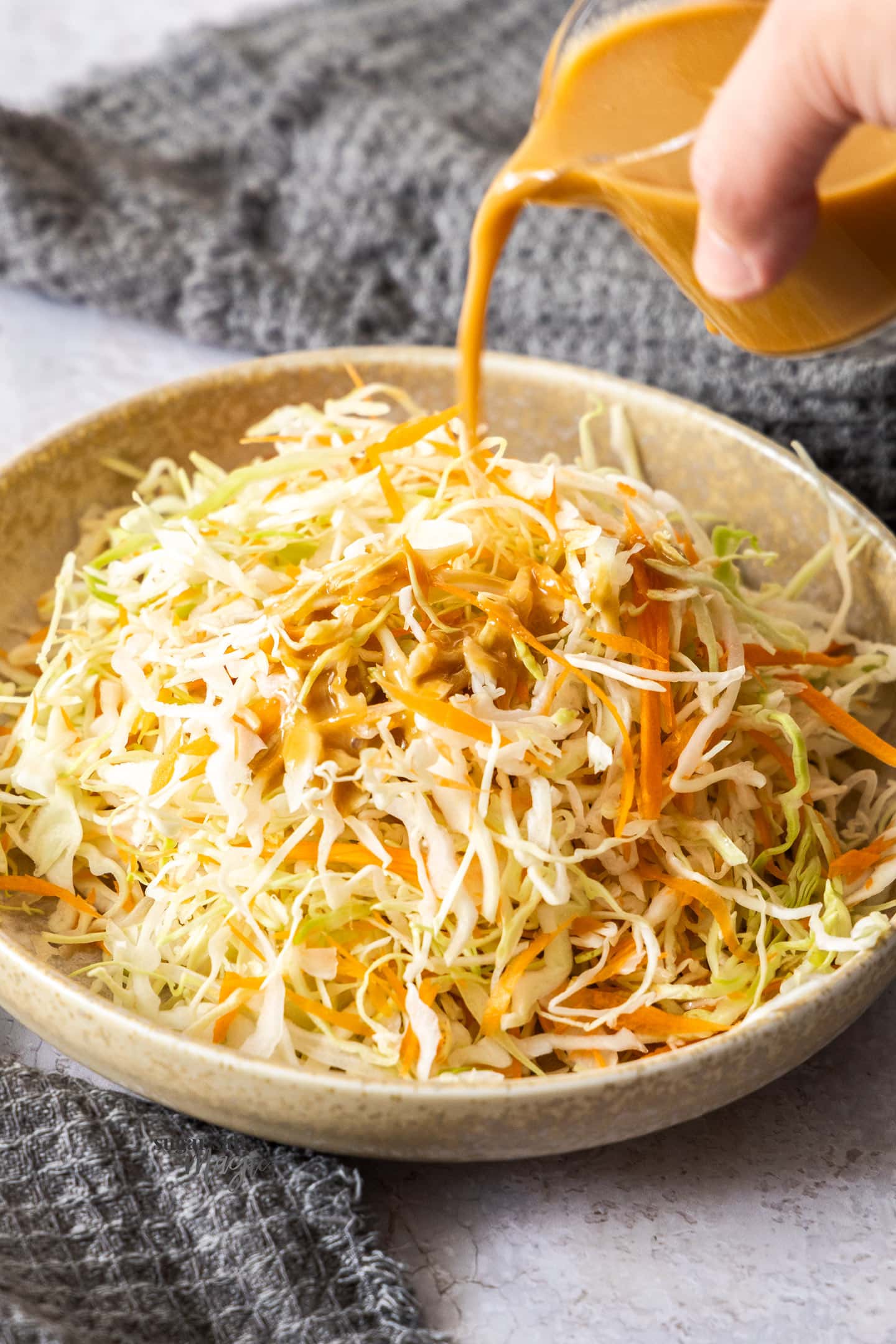
More recipes you’ll love
Did you try this Japanese sesame sauce recipe?
Leaving a rating and comment below the recipe is so helpful!
Hungry for more? Subscribe to the newsletter for free recipes straight to your inbox. Also, follow along on Facebook, Pinterest and Instagram.
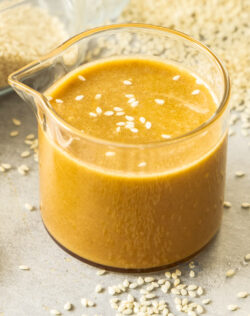
Ingredients
- 1 ½ tablespoons white sesame seeds, or pre-toasted (notes 1)
- 2 tablespoons unseasoned rice wine vinegar (notes 1)
- 1 ½ tablespoon soy sauce (notes 1)
- 1 tablespoon roasted sesame oil (notes 1)
- 1 tablespoon neutral flavoured vegetable oil (notes 1)
- 3 teaspoons brown sugar
- 2 teaspoons finely minced ginger
For best results, always weigh ingredients where a weight is provided
Equipment
- Saucepan
- Spice grinder / coffee grinder / mortar and pestle
- Mason jar, helpful but not necessary
Instructions
- If they aren’t already, toast the sesame seeds until golden in a dry pan over medium heat, shaking the pan often. Once golden they should smell nutty and a bit like popcorn
- Using a spice grinder, mini food processor or mortar and pestle, grind the toasted sesame seeds to a fine powder.
- Add the sesame seed powder to a jar with the remaining ingredients and shake well to combine. You can also just mix vigorously in a small bowl or jug.
- It’s ready to use. You can add more toasted sesame seed powder to make the consistency thicker and it will also make it nuttier and less tangy.
- Please take a moment to leave a comment & rating. It's appreciated and so helpful.
Notes
- Tablespoons: I use a standard Australian 20ml tablespoon (equal to 4 teaspoons). Check yours before measuring.
- Turn it into easy sesame noodles: Cook 250g dry noodles according to packet instructions and drain. Rinse with cold water then toss with just a dash of sesame oil. Now, to the saucepan you cooked the noodles in, add one batch of this sesame dressing, 1 tablespoon of sweet soy sauce / kecap manis, 1 tablespoon of peanut butter, and ½ -1 teaspoon of sriracha to taste (or similar hot sauce or chilli crisp). Bring it just to a simmer and add the noodles back. Toss well to combine, adding up to ¼ cup of water to get the consistency as you like it. Serve it up, topped with some finely sliced spring onions/scallions and my spicy Asian dukkah. Deeeeelicious!
- Nutrition details are approximate only – scroll below the recipe to find the full nutritional information. Serving size is based on this amount of sesame sauce being used on a salad of 4 large serves.
This post may contain affiliate links that earn me a small commission for my referral, at no extra cost to you. Thank you for supporting Sugar Salt Magic.

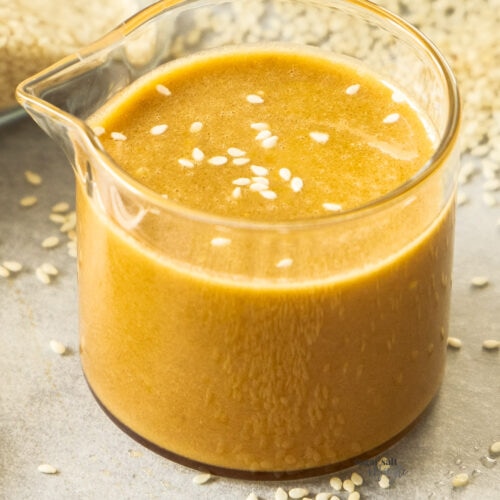
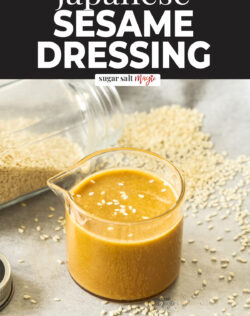

2 Comments on “Japanese Sesame Sauce (Goma Dare)”
Happy 8th Birthday Sugar Salt Magic, Marie do you know how many followers you have, I know I have always sent edited recipes to friends in Greece, Australia and U.K., Every single person has been amazed just how simple and delicious your recipes are.
Love how you tweet each recipe so as it’s perfect.
Going to try making Halloween recipes tomorrow ready for next week.
Give yourself a Gold Star ⭐️, keep wowing us with your delicious recipes 😘🙋♀️🌹🇬🇧🇦🇺🎉🎂💀🥳🐲👹👀👁️🕷️🕸️🍾
Thank you so much, Margaret. You literally made my day 🙂 Thank you so much for all your support and for sharing with your friends and family too. Happy Halloween baking 🙂